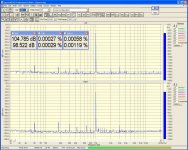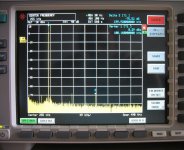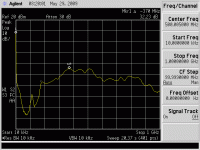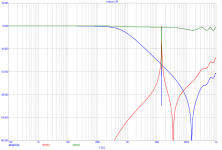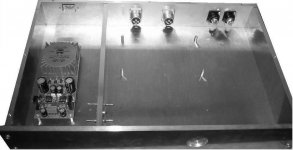syn08 said:
sound card is though not the best tool for serious measurements,
Agreed.
syn08 said:In single ended is much worse, but still acceptable for the DIYer.
Same card, same everything, in single ended mode. It pretty much sucks. Note the 60Hz harmonics, the channels asymmetry and the S/N ratio plunging down.
Attachments
BV said:Can You try it at 1V rms (0dBV)output signal?
Later, I'm on the road now.
BV said:Can You try it at 1V rms (0dBV)output signal?
Balanced, 0dBVrms. Much worse, of course.
Attachments
Thanks for that measurement! I was planning to purchase an ESI Juli@, but the EMU card seems to be a better choice in the same price range, maybe (except for the 48kHz restriction, but I haven't checked that for the Juli@ )syn08 said:Here's what EMU 1212M can do in balanced mode. In single ended is much worse, but still acceptable for the DIYer.
- Klaus
KSTR said:Thanks for that measurement! I was planning to purchase an ESI Juli@, but the EMU card seems to be a better choice in the same price range, maybe (except for the 48kHz restriction, but I haven't checked that for the Juli@ )
- Klaus
You are welcomed. Again, the limitation applies only for the internal loop (which you shouldn't use, anyway); you can use 192KHz to analyze an external signal.
Definitely. But we can agree it's pretty OK to do relative measurements (looking at changes) at least, can't we?syn08 said:I have posted quite some time ago the reasons why a sound card is though not the best tool for serious measurements, I'll find the reference and repost.
- Klaus
KSTR said:Definitely. But we can agree it's pretty OK to do relative measurements (looking at changes) at least, can't we?
- Klaus
Maybe, I don't know. I don't use a sound card for my regular measurements, I quickly got sick of the dependencies on the signal level, AC coupling only, lack of attenuators, unknown bandwidth, etc... And looking at that board full of cheap electrolytics makes me dizzy.
syn08 said:
Balanced, 0dBVrms. Much worse, of course.
This is still very good, absolute number considered. But as I am interested in preamp circuits that produce almost no measurable higher order harmonics above 3rd, this result would be unacceptable. Probably a combination with notch filter would help, provided it does not rise noise background.
Do any of these (or other) software packages work with a National Instruments DAQ card? Are they limited exclusively to sound cards?
I am going to try it with my TASCAM US-122 device, I hope it works well.
PS: Thank you Pavel for saving the thread.
PS: Thank you Pavel for saving the thread.
My intent is to show results with a box milled from 8mm Al plates, after it is produced. I believe in 2 or 3 weeks.
Pavel,
what do you think of this material, a sandwich of aluminum foam between aluminum panels?
http://www.gecom-technologies.com/ems_haupt.htm
and especially
http://www.gecom-technologies.com/ems_messungen.htm
(@all: translate with google if you don't read german)
From the measurements they provide this looks pretty nice.
They are also trying to get into the HighEnd realms, from what I can see they do it very right, especially as they are very concerned with HF ingress and clean power supply. Devices that look that ugly as these have to be good 😉
http://www.gecom-technologies.com/audio_haupt.htm
(some english text there)
http://www.gecom-technologies.com/audio_entwicklung.htm
- Klaus
what do you think of this material, a sandwich of aluminum foam between aluminum panels?
http://www.gecom-technologies.com/ems_haupt.htm
and especially
http://www.gecom-technologies.com/ems_messungen.htm
(@all: translate with google if you don't read german)
From the measurements they provide this looks pretty nice.
They are also trying to get into the HighEnd realms, from what I can see they do it very right, especially as they are very concerned with HF ingress and clean power supply. Devices that look that ugly as these have to be good 😉
http://www.gecom-technologies.com/audio_haupt.htm
(some english text there)
http://www.gecom-technologies.com/audio_entwicklung.htm
- Klaus
IMO we have 2 completely separated issues:
1) material of the box, and its shielding properties (including linearity, non-saturation),
2) leaks in the shielding box (even if made of 100% EMI proof material) like insulated connector mount, power supply input.
1) material of the box, and its shielding properties (including linearity, non-saturation),
2) leaks in the shielding box (even if made of 100% EMI proof material) like insulated connector mount, power supply input.
Hi Pavel;
speaking again about observing of distortions, did you try something like this?
http://en.wikipedia.org/wiki/Lissajous_curve
Sometimes it is very revealing, especially when phase modulation is involved. I used it developing guitar effects.
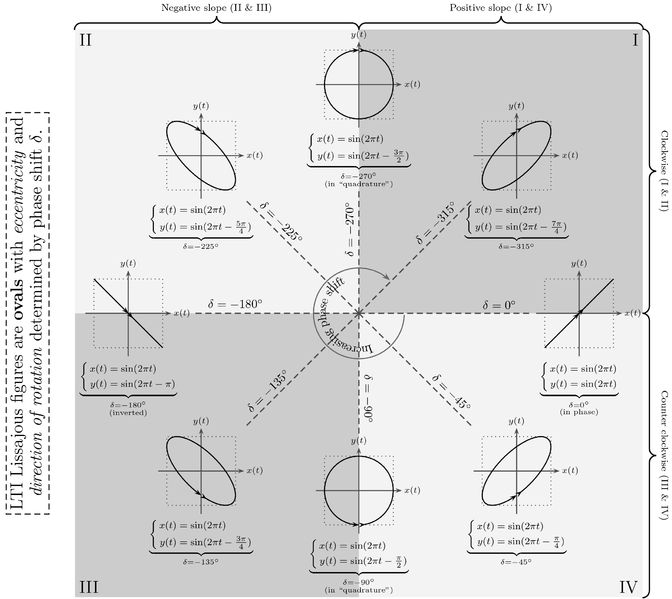
speaking again about observing of distortions, did you try something like this?
http://en.wikipedia.org/wiki/Lissajous_curve
Sometimes it is very revealing, especially when phase modulation is involved. I used it developing guitar effects.

- Status
- Not open for further replies.
- Home
- Amplifiers
- Solid State
- pre standard two preamp, and development of measurement methods
